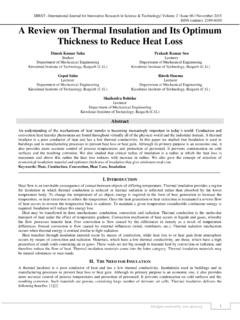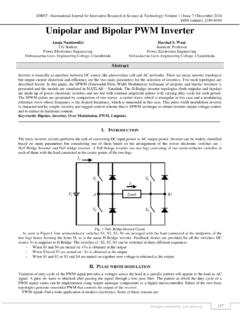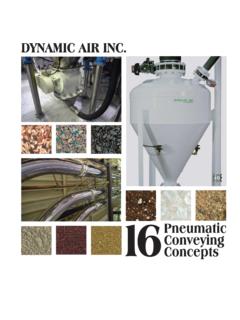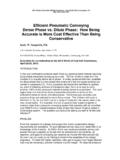Transcription of Design of Pneumatic Conveying System - IJIRST
1 IJIRST International Journal for Innovative Research in Science & Technology| Volume 3 | Issue 11 | April 2017. ISSN (online): 2349-6010. Design of Pneumatic Conveying System Akhil Raj P Anish Joseph UG Student UG Student Department of Mechanical Engineering Department of Mechanical Engineering Saintgits College of Engineering, Kottayam-686532, Kerala, Saintgits College of Engineering, Kottayam-686532, Kerala, India India Harinarayanan S Er. Tobin Thomas UG Student Assistant Professor Department of Mechanical Engineering Department of Mechanical Engineering Saintgits College of Engineering, Kottayam-686532, Kerala, Saintgits College of Engineering, Kottayam-686532, Kerala, India India Abstract Conveying of powder like substance in industries are used by conventional conveyors such as bucket elevators, screw conveyors.
2 In case of volatile or expensive materials such as Titanium dioxide, which is used mainly in paint industries, usage of conventional conveyors is not economical. Titanium dioxide powder is used for the production of inks, plastics, textiles, ceramics etc. It is commonly produced by the chloride route process of Rutile grade pigment. Due to the fine powdering nature of the material this System has certain problems like frequent spillage and fine powder escaping. Though some amount of powder is regained with the help of filtrate recovery process, this process is time consuming and expensive. Thus this spillage and other associated troubles are found to be one of the serious problems faced by the industries. Here fully refined powder material is wasted whereby the industries suffer huge losses both directly and indirectly.
3 Hence this study is to determine the reasons behind this problem and to suggest a suitable remedy. As a long term solution, replacement of the conventional Conveying System with a Pneumatic Conveying System was suggested. Keywords: Titanium dioxide powder, screw conveyers, bucket elevator, Pneumatic Conveying System _____. I. INTRODUCTION. Pneumatic Conveying systems are basically quite simple and are eminently suitable for the transport of powdered and granular materials in factory, site and plant situations. The System requirements are a source of compressed gas, usually air, a feed device, a Conveying pipeline and a receiver to disengage the conveyed material and carrier gas. The System is totally enclosed, and if it is required, the System can operate entirely without moving parts coming into contact with the conveyed material.
4 High, low or negative pressures can be used to convey materials. For hygroscopic materials dry air can be used, and for potentially explosive materials an inert gas such as nitrogen can be employed. A particular advantage is that materials can be fed into reception vessels maintained at a high pressure if required. Pipelines can run horizontally, as well as vertically up and down, and with bends in the pipeline any combination of orientations can be accommodated in a single pipeline run. Conveying materials vertically up or vertically down presents no more of a problem than Conveying horizontally. Material flow rates can be controlled easily and monitored to continuously check input and output, and most systems can be arranged for completely automatic operation.
5 Pneumatic Conveying systems are particularly versatile. A very wide range of materials can be handled and they are totally enclosed by the System and pipeline. This means that potentially hazardous materials can be conveyed quite safely. There is minimal risk of dust generation and so these systems generally meet the requirements of any local Health and Safety Legislation with little or no difficulty. II. MODE OF Conveying . For continuous Conveying and batch Conveying if the batch size is large, two modes of Conveying are recognized. If the material is conveyed in suspension in the air through the pipeline it is referred to as dilute phase Conveying . If the material is conveyed at low velocity in a non-suspension mode, through all or part of the pipeline, it is referred to as dense phase Conveying .
6 Dilute phase Almost any material can be conveyed in dilute phase, suspension flow through a pipeline, regardless of the particle size, shape or density. It is often referred to as suspension flow because the particles are held in suspension in the air as they are blown or sucked through the pipeline. A relatively high velocity is required and so power requirements can also be high but there is virtually no limit to the range of materials that can be conveyed. All rights reserved by 246. Design of Pneumatic Conveying System ( IJIRST / Volume 3 / Issue 11/ 044). There will be contact between the conveyed material and the pipeline, and particularly the bends, and so due consideration must be given to the Conveying of both friable and abrasive materials.
7 With very small particles there will be few impacts but with large particles gravitational force plays a part and they will tend to skip' along horizontal pipelines. Many materials are naturally capable of being conveyed in dense phase flow at low velocity. These materials can also be conveyed in dilute phase if required. If a high velocity is used to convey any material such that it is conveyed in suspension in the air, then it is conveyed in dilute phase. Fig. 1: Dilute phase flow III. REQUIRMENT OF Pneumatic Conveying System . In a typical Pneumatic Conveying System there are different components for feeding the material, transporting the material and also for discharging .The new Design will have the following components. Drive System Air movers Pipeline sections Material feeding System In addition to the above mentioned devices, usually an air-dryer is also installed just after the air mover unit.
8 This is done to ensure that the air discharged from the air mover System has the required specific humidity and the required moisture content. For the effective Conveying of solid the air must have minimum moisture content this is achieved by using an air cooling System after the air mover. The cooling of air will make the Conveying air homogeneous that is any foreign particle (oil or dirt content). from the air mover lubricant is condensed due to the cooling. Usually coils of water at lower temperature than the atmosphere is used for this purpose. The range of temperature of the discharged air is 15 C-30 C. IV. System Design . In order to Design the Pneumatic Conveying System the criteria for designing must be regarding the requirements mentioned in the previous chapter such as Design of pipeline diameter, length and the material of the pipe.
9 Head loss produced inside the pipeline due to friction and bend section. Selection of Air mover System , drive System , material feeding System and air drying System . All of the above criteria is designed and selected by using the standard Design calculations from the Pneumatic Conveying System Design guide' by David Mills. Thus for Design calculations mainly two aspects about Pneumatic Conveying are used and they are. Mode of Conveying For designing the new Pneumatic System layout the primary factor to look into is the mode of Conveying or mode of operation. Since the System that is most suitable for Conveying powder like particle is Closed loop System , the most ideal mode for Conveying is Dilute phase Conveying . For dilute phase Conveying the important variable to note is the solid loading ratio'.
10 1) Mode of Conveying . 2) Conveying capacity. 3) Conveying pressure All rights reserved by 247. Design of Pneumatic Conveying System ( IJIRST / Volume 3 / Issue 11/ 044). Solid loading ratio ( ). Solids loading ratio or phase density, is a useful parameter in helping to visualize the flow. It is the ratio of the mass flow rate of the material conveyed divided by the mass flow rate of the air used to convey the material. It is expressed in a dimensionless form. For plug type flow the use of solids loading ratio is not as appropriate, for the numbers do not have the same significance. Since the materials have to be very permeable, air permeates readily through the plugs. Maximum values of solids loading ratio, therefore, are only of the order of about 30, even with high values of Conveying line pressure drop.











